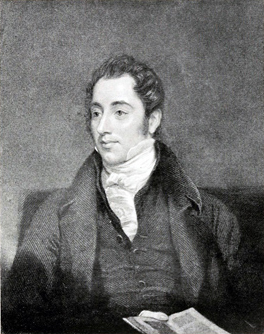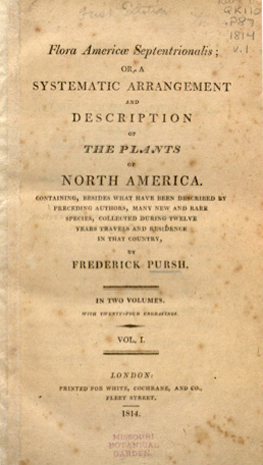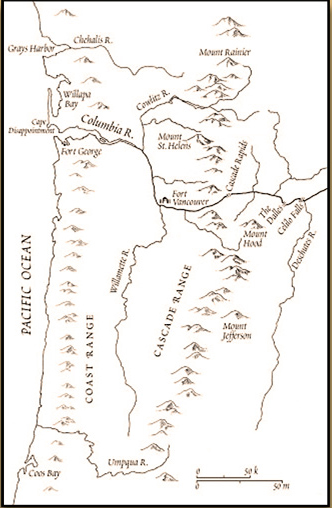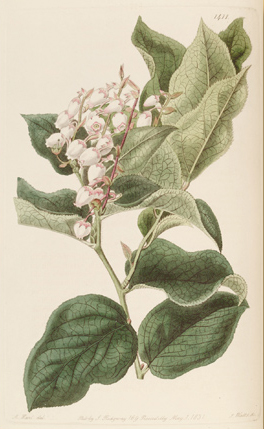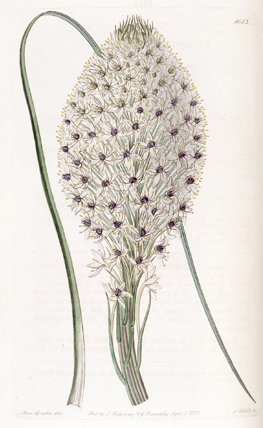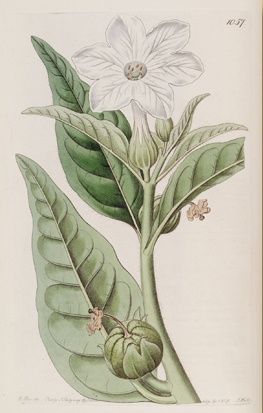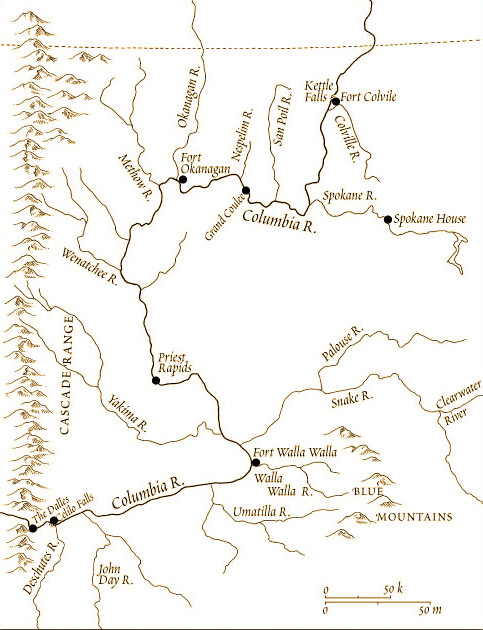In the Pacific Northwest, David Douglas followed in the footsteps of Lewis and Clark and David Thompson many times verifying Lewis’s plant collection.
Sailing to the Pacific Northwest
William Jackson Hooker (1785-1865)
R. W. Oliver, ed., Makers of British Botany, Cambridge (1913), Plate 12. Line engraving dated 1834. Artist and engraver unknown
William Jackson Hooker, who later became the first director of the Royal Botanical Gardens at Kew, in London, was a lecturer at the University of Glasgow when Douglas met him in 1820.
David Douglas was born in the village of Scone, Perthshire, in 1799. An outside lad from the beginning, he cared more for fishing and rambling than school, and by age eleven was working summers under the head groundskeeper at the local manor. After a thorough gardening apprenticeship, the 21-year-old Douglas took a starter position at the Botanic Gardens of Glasgow University just as a new lecturer named William Jackson Hooker came on board. Hooker, who would later become the first director of Kew Gardens, was already a famous name in British botany, and had the connections to put Douglas’s energy and talent to use. He would remain a mentor and close friend for the rest of the Douglas’s life.
It was Hooker who arranged Douglas’s first outing as a collector for the London Horticultural Society, and that trip to the eastern United States allowed Douglas to display his talent not only for finding interesting plants, but also for preserving their seeds, slips, and bulbs in ways that would allow them to grow again in Great Britain. After returning to London, the young collector also penned a monograph on American oaks that demonstrated his thorough knowledge of earlier works compiled by André Michaux and Frederick Pursh, and reflected his own thoughts about various oak species for carpentry and shipbuilding.
The Horticulture Society assigned Douglas a far more ambitious undertaking when they booked him passage aboard a Hudson’s Bay Company vessel bound for the Columbia River. Before shipping out in late July 1824, Douglas researched his new collecting territory extensively. He read George Vancouver’s account of Great Britain’s 1792-96 Pacific Coast surveying expedition, and interviewed Archibald Menzies, who had served as surgeon and naturalist on that trip. Douglas studied Alexander Mackenzie‘s journey across the Rocky Mountains to the Fraser River and Bella Coola, carried out in 1793 for the North West Fur Company. With a particular eye for natural history, he pored over Nicolas Biddle’s published account of the Lewis and Clark Expedition, and procured a copy of Pursh’s Flora Americae Septentrionalis, which included taxonomic details of their plant collections, to carry with him for study on the nine-month voyage around Cape Horn.
With these underpinnings, Douglas recognized landmarks from Vancouver’s and William Clark’s maps as soon as he sighted Cape Disappointment at the Columbia River’s fearsome bar, working his way around Baker Bay, Tongue Point, and Point Adams. The collector continued to name familiar sentinels as he moved inland and viewed the snowcapped volcanoes of the Cascades. “A very conspicuous conical mountain is seen in the distance far exceeding the others in height; this I have no doubt is Mount Jefferson of Lewis and Clarke.”[1]David Douglas, Journal Kept by David Douglas, 1823-27, (London: William Wesley & Son, 1914), 106.
On the Lower Columbia
Within a few days of stepping ashore, Douglas was introduced to Chinook headman Comcomly [or Concomly], who had known Lewis and Clark well during their winter at Fort Clatsop. In his interactions with the tribal cultures of the lower Columbia, Douglas, again emulating the Corps of Discovery, helped his own cause by quickly learning Chinook jargon, a trade language that allowed him to communicate with tribal and mixed-blood fur trade families throughout that region. Over the course of the next two years, Comcomly’s network of kin guided Douglas from Astoria to Grays Harbor, providing him with food, introductions, companionship, deep ethnographic knowledge, and several important collections of flora and fauna. The fact that Douglas collected lower Columbia specimens during all seasons of the year, through several annual cycles, allowed him to expand on the solid base of natural history data begun by Lewis and Clark during their time at Fort Clatsop.
Verifying Lewis’s Plant Collection
Salal Gaultheria shallon
John Lindley, Edwards’s Botanical Register, vol. 17 (1831), plate 1411. Artist and engraver unknown.
“On stepping on the shore Gaultheria shallon was the first plant I took in my hands.”[2]Ibid., 102.
Beargrass Xerophyllum tenax
John Lindley, Edwards’s Botanical Register, vol. 19 (n.s., vol. 6, 1833), plate 1613.
Drawing by Sarah Ann Drake (1803-1857). Engraving by L. Watts.
“It is one of the greatest ornaments of the western mountains, and the natives make baskets, hats, pouches, bags, bottles, mats for sleeping on, &c., of its strong foliage.”[3]Ibid., 2:178.
In his daybook, Douglas kept a running list of his collections that often revealed the depth of his awareness of who had come before him. When he saw the familiar evergreen shrub salal (Gaultheria shallon), he wrote “Called by the natives ‘Salal,’ not ‘Shallon’ as stated by Pursh, figure and description good; abundant (as is very correctly observed by Mr. Menzies) in all the pine forests.”[4]Journal, 104. Here Douglas adjusted Pursh’s account of a Corps of Discovery collection to fit his own hearing of Chinook jargon, then recalled the oral accounts of Archibald Menzies to reflect on the plant’s range. He then added to the depth of the story by becoming the first of his cohorts to send viable salal seed back to England, where it was propagated and sold as a ground cover. The fact that salal has since escaped to spread across a variety of habitats in the northern British Isles as a noxious weed adds a modern twist to all these collectors’ lore.
Having learned of the beautiful blue camas lily (Camassia quamash) from the writings of Lewis and Clark, Douglas paid close attention to the way local tribes dug, prepared, and cooked its bulbs even as he procured seed and packed his own dried bulbs in sand for the Horticultural Society. Douglas’s field notes include one family’s recipe for cooking camas in an earth oven, and he ended the account, as he often did, with a modest joke that included an historical nod to his predecessor. “Captain Lewis observes that when eaten in a large quantity they occasion bowel complaints. This I am not aware of, but assuredly they produce flatulence: when in the Indian hut I was almost blown out by strength of the wind.”[5]Ibid., 105.
The Pursh handbook Douglas carried with him provided a direct line to virtually all of Lewis and Clark’s plant collections, both the well-described and the mysterious. On July 19 of 1825, for example, Douglas departed from his Fort Vancouver headquarters in search of an undefined sedge, for which he had only a partial clue.
Early in the morning I left my residence in a small canoe . . . principally for the purpose of searching for and inquiring after the tuberous-rooted Cyperus mentioned by Pursh in his preface, the root of which is said to afford the natives food something like potatos when boiled. After a laborious route of twelve days along the shore north of Cape Disappointment, I was obliged reluctantly to return without being fortunate enough to meet with it. I observed several dead roots, washed on the shore by the surge and agreeing exactly with the description give by Lewis and Clarke, which I conjecture to be it.[6]Ibid., 104.
In a more positive light, Douglas obtained seeds for beargrass (Xerophyllum tenax,), a Lewis and Clark favorite about which he could write: “The natives at the [Grand] Rapids call it ‘Quip Quip.’ Pursh is correct as to their making watertight baskets of its leaves.”[7]Ibid., 144.
Indian Tobacco
Indian tobacco, Nicotiana quadrivalvis
Sydenham Edwards, The Botanical Register, vol. 13 (1827), plate 1057.
Drawing by M. Hart, Engraving by L. Watts.
“The Indians do not cultivate it near their camps or lodges, lest it should be taken for use before maturity.”[8] Journal, 141. See Native tobacco.
The single plant most often mentioned in the journals of the Corps was tobacco, including episodes in the Knife River Villages, among the Shoshone, and at the mouth of the Columbia that involved tribal-grown smoking material “of their own manufacture.” David Douglas was very curious about the origin of this tobacco, and began looking for it as soon as he arrived on the river. He collected information from fur trade workers about its spread, but only gradually homed in on native gardeners. “Whether its original habitats are here in the Rocky Mountains, or on the Missouri, I am unable to say, but am inclined to think it must be in the mountains,” he wrote in fall 1825. “I am informed by the hunters it is more abundant towards them and particularly so among the Snake Indians, who frequently visit the Indians inhabiting the headwaters of the Missouri by whom it might be carried in both directions.”[9]William Jackson Hooker, Flora boreali-americana, or, the botany of the northern parts of British America: compiled principally from the plants collected by Dr. Richardson & Mr. Drummond on the … Continue reading
When Douglas discovered a hidden tobacco plot on the lower Willamette River, he interviewed its Kalapuya gardener, then sent some specimens of the crop back to London. When compared with a sprig of tobacco that Lewis and Clark collected at the Mandan villages, it proved to be a cultivar of the same species, today known as Nicotiana quadrivalvis or Indian tobacco. The combined work of Douglas and the Corps proved that this species, a native to California, was part of a tribal trade network and extensive gardening practices that had been in existence long before white contact.[10]Jack Nisbet, Visible Bones: Journeys Across Time in the Columbia River Country, (Seattle: Sasquatch Books, 2003), 132-152. Or, as Douglas put it in his comments to William Jackson Hooker, tobacco is “abundant within the recesses of the Rocky Mountains, and westward to the Pacific Ocean, in all dry light soils; it is greatly esteemed by the different tribes for smoking, and is the only vegetable which the native of the Columbia cultivate.”[11]Hooker, 2:91.
In the Interior
As Douglas moved inland, his mentions of Lewis and Clark continued as long as he followed their routes. Like the captains, he shot at harbor seals at the Cascades of the Columbia. For the name of the long portage known to Hudson’s Bay Company voyageurs as The Dalles, he preferred “The Grand Rapids,” as they were called by Lewis and Clark.[12]History of the Expedition under the Command of Captains Lewis and Clark, to the Sources of the Missouri, thence Across the Rocky Mountains and Down the River Columbia to the Pacific Ocean. Performed … Continue reading When he saw the beautiful wildflower clarkia or elkhorn (Clarkia pulchella) that Pursh named for William Clark, he made sure to gather some good seed from it, and pack it carefully for transport aboard the Bay Company’s supply ship of fall 1825. That same clarkia, in full bloom, became the hit of a fundraising plant sale the Horticultural Society held in London during the summer of 1828.[13]Jack Nisbet, The Collector: David Douglas and the Natural History of the Northwest (Seattle: Sasquatch Books, 2009), 184.
Douglas himself did not board the fall 1825 ship that was supposed to provide his passage back to England. Intent on exploring inland, he wintered at Fort Vancouver and then spent most of 1826 circling the Hudson’s Bay Company’s interior posts. He called the Snake River “Lewis and Clarke’s River,” but for drainages upstream from there on the Columbia, he switched to a new source for geographical information: several of the fur traders he met had worked for North West Company agent and surveyor David Thompson, and although none of Thompson’s writings or maps had been published at that time, these former crewmen provided Douglas with oral accounts of the surveyor’s travels. When Douglas watched the voyageurs portage around an unnamed rapids a day’s journey south of Kettle Falls, he suggested that they call the riffle Thompson Rapids after “The first [white] person to descend the whole chain of the river from its source to the ocean.”[14]Ibid., 165.
In July of that same year, Douglas found himself back on the Lewis and Clark trail when he accompanied some fur traders to a Nez Perce encampment at the mouth of the Clearwater River. As he wandered the area in search of new plants, the collector chanced upon the “spot pointed out to me by the Indians where Lewis and Clarke built their canoes, on the way to the ocean, twenty-one years ago.”[15]Ibid., 200-01.
Notes
| ↑1 | David Douglas, Journal Kept by David Douglas, 1823-27, (London: William Wesley & Son, 1914), 106. |
|---|---|
| ↑2 | Ibid., 102. |
| ↑3 | Ibid., 2:178. |
| ↑4 | Journal, 104. |
| ↑5 | Ibid., 105. |
| ↑6 | Ibid., 104. |
| ↑7 | Ibid., 144. |
| ↑8 | Journal, 141. |
| ↑9 | William Jackson Hooker, Flora boreali-americana, or, the botany of the northern parts of British America: compiled principally from the plants collected by Dr. Richardson & Mr. Drummond on the late northern expeditions, under command of Captain Sir John Franklin, R.N. To which are added (by permission of the Horticultural society of London,) those of Mr. Douglas, from north-west America, and of other naturalists, 2 vols. (London: H.G. Bohn, 1829), 2:91. |
| ↑10 | Jack Nisbet, Visible Bones: Journeys Across Time in the Columbia River Country, (Seattle: Sasquatch Books, 2003), 132-152. |
| ↑11 | Hooker, 2:91. |
| ↑12 | History of the Expedition under the Command of Captains Lewis and Clark, to the Sources of the Missouri, thence Across the Rocky Mountains and Down the River Columbia to the Pacific Ocean. Performed During the Years 1804-5-6, 2 vols. (Philadelphia: Bradford and Inskeep, 1814), 2:127. |
| ↑13 | Jack Nisbet, The Collector: David Douglas and the Natural History of the Northwest (Seattle: Sasquatch Books, 2009), 184. |
| ↑14 | Ibid., 165. |
| ↑15 | Ibid., 200-01. |
Experience the Lewis and Clark Trail
The Lewis and Clark Trail Experience—our sister site at lewisandclark.travel—connects the world to people and places on the Lewis and Clark Trail.
Discover More
- The Lewis and Clark Expedition: Day by Day by Gary E. Moulton (University of Nebraska Press, 2018). The story in prose, 14 May 1804–23 September 1806.
- The Lewis and Clark Journals: An American Epic of Discovery (abridged) by Gary E. Moulton (University of Nebraska Press, 2003). Selected journal excerpts, 14 May 1804–23 September 1806.
- The Lewis and Clark Journals. by Gary E. Moulton (University of Nebraska Press, 1983–2001). The complete story in 13 volumes.
